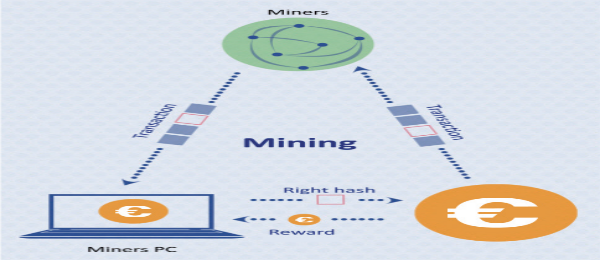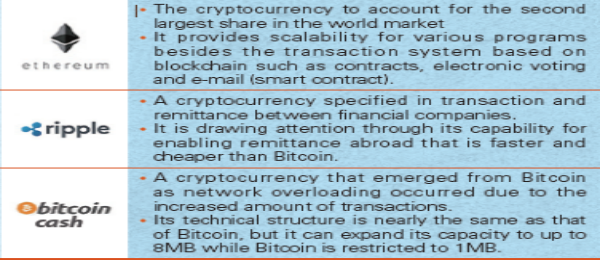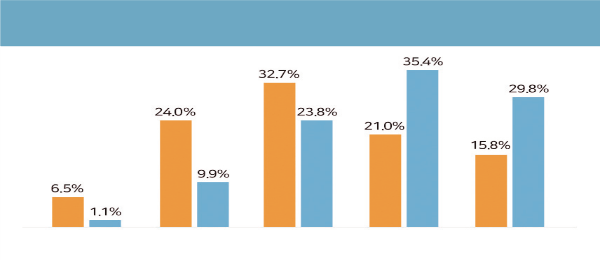Bitcoin was certainly one of the hottest issues in Korea at the beginning of 2018. There was an enormous interest in “virtual currency” within the students’ community due to its relative ease of accessibility and its unpredictable price fluctuations. As a movement for huge change is detected within the monetary market and becomes interrelated to the lives of everyday people, the Sungkyun Times (SKT) will present a series of articles on cryptocurrency in the April and May issues. This month, the SKT introduces the general concept of cryptocurrencies and their current position in Korea.
Cryptocurrency: Appearance of a New Financial Player?
What Is Cryptocurrency?
Cryptocurrency is a currency transacted online without using real “physical” money, such as bills or coins. Since it is invisible and represented only on computers, it was initially referred to as “digital money” or “virtual money”. It is called cryptocurrency, because it is a currency utilizing encryption technology, while the Korean government utilizes the term “virtual currency”.
Unlike physical currency which is printed and controlled by the government or central bank of each country, cryptocurrency is valued according to the rules set by the first developer. Since it is distributed based on Blockchain technology, the government cannot guarantee the value or supply of a currency, and a fixed face value corresponding to each monetary unit does not exist. Similarly, the value of any given cryptocurrency may vary moment to moment; that is, the variability is high. Since the development of Bitcoin in 2009, 1508 cryptocurrencies have been transacted in the world market as of February 2018. Representative currencies include Bitcoin, Ethereum, Ripple, and Bitcoin Cash.
Blockchain: Foundation of Cryptocurrency
Blockchain was a new technology that was developed in conjunction with the development of Bitcoin; the two have an indivisible relation. It is a base system not only for Bitcoin, but also for other cryptocurrencies, services, and products. Unlike the existing method in which all trade information is saved concentrically and solely in the bank, Blockchain is a massive dispersal record accounting database technology.
Every time a new trade occurs, information is moved into a separate block and linked to the existing account. A record

that A sent 100,000 to B, for instance, is saved in numerous computers with Internet access. The trade information within the block is open to anyone who is connected through the Internet, and anyone can create, copy and save it. The chain of information shows a high level of security since each of them is set to be matched with the others. The loss of any record is fundamentally prevented through matching the records at least tens of thousands of times, and copies that do not match are discarded.
The authenticity of the records can be identified via the hash function, a computer encryption technology that generates fixed-length pseudorandom numbers, referred to as a “hash value”, out of whatever data it receives. The relation between the potato and the hash brown would be helpful to understand this principle. Making a hash brown from a potato is possible but remaking the potato with the hash brown in reverse would be impossible. Likewise, each block (the potato) in the Blockchain (the hash brown) has a unique number, a hash value, to connect itself to other blocks; since comparing the outcomes are easy but finding the hash function inputs are not, falsification can be prevented.

Mining and the Miners
Once a developer develops a cryptocurrency, people can “mine” it. The act of getting the cryptocurrency is called “mining,” and those who get currency through mining are called “miners.” It is named as such because the process is like a digital version of mining gold. Mining is a system of issuing cryptocurrencies by interpreting the hash values of each block in which the trade record of each user is saved within a high-performance computer and listing the outcome into the Blockchain, an open record account. In other words, it is the same as getting a cryptocurrency as a reward for proving the trade saved in the block and recording it by solving the hash value through the performance of one’s computer. A high-performance Graphics Processing Unit (GPU) is generally required in order to perform a difficult calculation repetitively, and exclusive programs and groups for mining have been appearing as well. The more minors in the field as time passes, the higher the level of difficulty for mining as security becomes tighter.

Developers can create their own advantages in mining through several methods such as pre-mining some of the money or using a private, exclusive mining code. Miners, meanwhile, can sell what they have mined directly on the cryptocurrency market right after mining, or just keep it in their “wallet,” a cryptocurrency depository, and sell it when they gain mining profits through profit-taking. Likewise, people can usually “mine” cryptocurrency by themselves, or buy it on the market.
Bitcoin and Altcoin
Bitcoin: Birth of Cryptocurrency
Bitcoin was the first cryptocurrency to be developed by an anonymous programmer under the pseudonym Satoshi Nakamoto in 2009. It is a blend of the words “bit”, a basic unit of information in a computer, and “coin”. Though Australian entrepreneur Craig Wright declared himself to be the creator of the Bitcoin in 2016, his claim ended up being controversial due to the lack of any crucial evidence, and the genuine identity of Satoshi Nakamoto is still to be unveiled. Wright is actually currently being sued over the ownership of the Bitcoin name and the basic technology patents for it from his deceased partner, Dave Kleiman.
Since it is operated through peer-to-peer (P2P) technology and dispersed through numerous computers, the owners or issuing entities do not actually exist. P2P is a technology in which individuals are directly connected within the internet and share files. Bitcoin can be exchanged into currencies of any country, and though limited, it is performing some of the functions of physical as well: as a medium of exchange, a store of value and a measure of value. Since it is transacted anonymously, people can open their “wallet” without any process of identification and any restriction on the date, time or amount in the wallet; the accessibility is great, but there are concerns regarding the possibilities for criminal misusage.
The total amount of Bitcoin has been limited to 21 million bitcoins, unlike normal currency that can be issued without any limitations. About 16.8 million bitcoins, which comes to nearly 80% of the total, have been mined up to now. The money supply is strictly restricted as well. The supply limit was initially set to release 50 bitcoins every 10 minutes for the first four years since it was developed, but this has been cut in half every four years since then; 12.5 bitcoins have been released every 10 minutes since December 2016, and if it continues, most bitcoins would have been issued by around 2050. Bitcoins, however, can be subdivided into eight decimal places, so augmenting the amount of currency within a limited budget would be possible if needed.
Altcoins: Appearance of the Alternatives
Every cryptocurrency that is being transacted in the world market, except for Bitcoin which is the most renowned one, is referred to as an Altcoin. It is a blend of the words “alt” from alternative and “coin” from bitcoin. Many developers started to develop altcoins in order to solve some of the problems of Bitcoin, the first cryptocurrency, such as the slow transaction time. As the development began, the market share started to change as well: the share of Altcoin in the world cryptocurrency market was only about 6% until 2013, but it increased to nearly 66% in February 2018. Ethereum, Ripple, and Bitcoin Cash are the most representative Altcoins.

Cryptocurrency in Korea
Bitcoin Boom and Its Shade
Thanks to the ease of accessibility, the simple procedure of opening a “wallet” and the high possibility of profit-making through short term investment due to high price fluctuation, many Koreans dived into the Bitcoin market. According to the Financial Supervisory Service, the number of virtual accounts issued by the commercial banks for the cryptocurrency market reached about 3.8 million at the end of 2017.
In particular, a cryptocurrency boom among the 20s and 30s in a hope of making a big fortune on a single occasion rose as a serious social problem. A survey of users’ age groups of the top 10 Bitcoin related Apps conducted by WiseApp, an application analyzing site, showed that more than half of the users were in their twenties and thirties; users in their twenties and thirties took up 24% and 32.7% of the survey respondent respectively. The problem is that despite the numerous people jumping into the market looking to make high profits, many are suffering great losses because of the heavy ups and downs. Even teenagers and university students are investing their money in the cryptocurrency market. Last February, there was even an incident in which one university student suffering from depression, due to a cryptocurrency crash, killed himself. Consequently, the Korean government decided to prohibit cryptocurrency transactions via virtual banks and instituted a real-name cryptocurrency transaction system.
Institution of Real-name Cryptocurrency Transaction System
The Korean government instituted the real-name cryptocurrency transaction system on January 30th, 2018 in order to secure transparency in cryptocurrency transactions, regulate any illegal transactions such as market manipulation, anti-money laundering and tax evasion, and prevent any related crimes. According to the system, opening any new virtual account from the cryptocurrency market will be banned; deposits and withdrawals will only be admitted between identified bank accounts connected with the market, with investors who were transacting via virtual accounts also being required to move to bank accounts as well. Since the banks can identify the names, account numbers, and identification numbers of the users, it will be able to block minors under the age of 19 and foreigners without permanent residency in Korea, from investing.
As cryptocurrency transactions and the natural price-decisions were influenced by the institution of the system, however, many are upset with the decision of the government. As the banks are showing a passive stance in opening new accounts for cryptocurrency transactions, the rate of transferring from virtual accounts to bank accounts is low as well. Given that Korea is one of the first countries to regulate cryptocurrency, there is a need to keep an eye on the upcoming situations without making any rash conclusions.

Since financial matters cannot be separated from the daily lives of people, it is very important for Kingos to understand the current cryptocurrency wave. Therefore, next month, the SKT will look at some issues related to cryptocurrency, perspectives from different fields and measures taken by some governments around the world.
